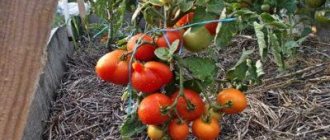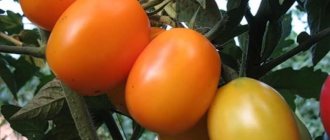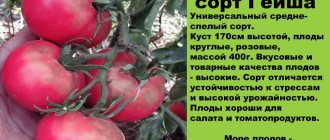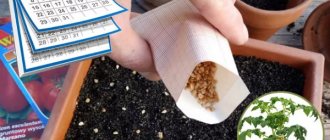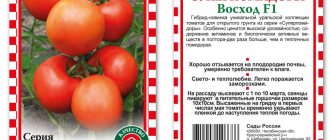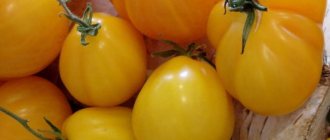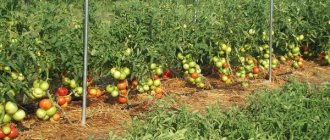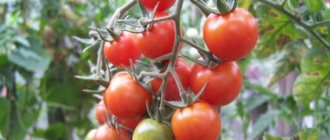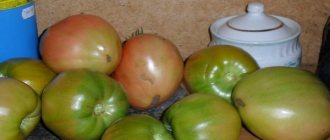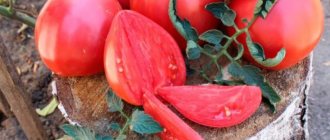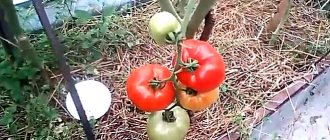Vegetable growing » Tomatoes
0
1918
Article rating
Kira Stoletova
The Podarochny tomato variety has been popular among gardeners for many years. Most use these beautiful fruits commercially, but some grow them for personal consumption. Tomatoes of this variety are well transported and do not lose their properties during processing.
Characteristics of tomato variety Podarochny
Description of the variety
Gardeners grow this variety of vegetable in different parts of the Russian Federation, including Moscow. It is believed that breeders specially bred a variety of this variety for cultivation in any region of the country.
Gift tomatoes are a mid-season variety. The product is determinant, which means that after a certain amount of cluster ovary growth stops. This also indicates that the plant needs constant shaping and removal of excess shoots in order to eliminate the overload of fruits.
The ripening process from the start of planting seedlings is at least 100 days. The height of the stem does not exceed 80 centimeters; determinacy limits the height. The tomato leaves are medium in size, light green in color and have the usual shape for this fruit.
Present tomatoes are not standard varieties. Many new full-fledged shoots are formed near the root base. With timely intervention, stepchildren can be multiplied, thereby increasing the yield.
Tomato Gift
This variety is intended for cultivation in vegetable gardens, under film and in greenhouses. It is important to follow the instructions and planting plan during cultivation.
Podarok tomatoes are practically not susceptible to diseases and actively resist attack by pests. They are able to withstand extreme heat and do not lose their presentability even during periods of drought. This tomato variety is frost-resistant and can easily tolerate a lack of light, although it is considered a light-loving vegetable.
Description and characteristics of the Fairy's Gift tomato, reviews, photos
Early ripening (93-95 days from germination to ripening), productive , determinate, medium-sized tomato variety. Recommended for growing in greenhouses and open ground.
The bush is up to 1 meter high , in the greenhouse a little higher. It requires tying the plant to a support and pinching. It is best to form into 3 stems.
photo by Alla Skuratovich
Basic qualities of fruits
The fruits are heart-shaped, dense, orange in color at maturity, weighing 100-120 grams , excellent tomato with a sweet taste. These tomatoes are perfect for fresh salads, making juices and sauces.
Advantages of the variety : resistant to verticillium, fusarium wilt, TMV. Increased beta-carotene content.
Fruit characteristics
Tomato Altai Orange
Tomatoes Gift description and characteristics of the variety:
- Productivity. Ripening occurs in mid-July and lasts until the last days of August. From 1 sq/m the gardener collects from four to five kilograms of product;
- Shape and color. The Podarka variety has a round shape and is bright red in color. The fruits are isosceles, there are no ribs or roughness;
- Mass and taste. The weight of the largest fruit is from one hundred to one hundred and fifty grams. It all depends on the soil and conditions. The product has a pleasant sweet taste, with a slight sourness at the end. The vegetable contains a small amount of dry matter. This allows you to maintain presentability for a long time and protects the fruit from cracking.
Note! Gift grade tomatoes are not suitable for seaming; after heat treatment they lose their structure, the skin cracks, and the entire fruit falls into segments. It is better to eat the vegetable fresh or use it as a paste.
The variety of these tomatoes differs from others in the presence of inflorescences; the first are formed not on the first, but on the ninth or eighth leaf. Further inflorescences are formed through a leaf or two. There are no joints on the stalks.
Additional Information. This species is not considered a hybrid and does not have F1 class varieties of the same name.
Features of growing Sensei tomatoes, planting and care
We recommend sowing the seeds of this tomato for seedlings 60-65 days before the intended planting in the ground. When planting seedlings in a permanent place per 1 sq. Place up to 4 plants per meter of prepared area.
Further care for tomatoes consists of timely watering, fertilizing with complex mineral fertilizer, pinching and preventive measures to protect against diseases and pests.
You can see other interesting varieties of tomatoes with photos, descriptions and reviews in our Catalog of Tomato Varieties. Enjoy watching.
If you grew Sensei tomatoes, please write whether you liked them or not. What was the yield and taste of the fruits like under your climatic conditions? How do you rate the disease resistance of this variety? Briefly describe what, in your opinion, are the advantages and disadvantages of this tomato. If possible, attach a photo of your tomatoes to your comment. Thank you!
Your reviews of the Sensei tomato and additions to the description will help many gardeners evaluate this variety more objectively and decide whether it is worth planting or not.
This is a natural variety of tomato. Therefore, we recommend taking seeds from a ripe fruit and using them for planting in subsequent seasons.
Growing process
Tomato Peter 1: characteristics and description of the variety
Since this plant is not a hybrid, you can prepare the seeds yourself from tomatoes or buy them at any store. The Tomato Irkutsk chain of stores is ready to offer seed material. You can easily purchase Irkutsk tomatoes on the official website without leaving your home.
Before planting, it is important to pre-prepare the seeds. Self-extracted seed must be calcined in the oven; store-bought products need to be treated with a solution of potassium permanganate.
It is necessary to prepare the soil before planting, lightly water the soil, and have enough water.
Prepared seeds should be planted in a container with fertilized soil in March. Subsequently, the container is covered with film. When sprouts appear, the film is removed, and seed germination continues in the open sun until the first leaves appear. The seedlings are ready for picking.
Picking up seedlings
After 60 days, most often this date falls at the end of May, the bushes are transplanted into open soil.
Plants need to be tied up so that a large number of fruits do not injure the bush. To accelerate ripeness, seedlings are planted under film or grown in a greenhouse, observing the required temperature conditions. It is worth remembering that the harvest grown in the garden is much tastier and has a pronounced color; in the greenhouse the vegetable turns out to be more sour and paler.
Important! There should be a certain distance between the rows - from thirty to forty centimeters, between seedlings - 70 centimeters.
Cleaning takes place from mid-July to the twentieth of August. Professionals harvest tomatoes without stems.
To ensure a large and high-quality harvest, fertilizers and mineral fertilizers should be added to the soil. Humus is a good fertilizer.
If you plan to plant in the garden, then a draft-free area will be a favorable place. The place should be well lit by the sun, but it is better to protect the side shoots from sunlight. Ideal temperature for growing: minimum - 16 degrees, maximum - 28 degrees. At low temperatures, fruit growth slows down; at high temperatures, the plant and fruits burn. Exposure to direct sunlight is important at the first stage, when inflorescences form and fruits form, then the need for bright light decreases.
If cultivation takes place in a greenhouse, then the main condition for obtaining a good harvest is the movement of dry air. This movement can be accomplished with the help of a fan or with regular ventilation of the greenhouse.
Hardening off seedlings using ventilation
Caring for tomato seedlings
You can plant seedlings in a heated greenhouse whenever you want.
In order to get healthy seedlings, you need to prepare the substrate and containers. The soil for it is prepared from several components:
- garden soil;
- sand;
- rotted mullein;
- wood ash;
- and sometimes sawdust from fruit trees is added.
Drainage from coarse sand is poured into the container, and the soil is leveled on top. Seeds soaked in a solution of potassium permanganate in the evening are washed with running water and spread evenly on the surface. Sprinkle with soil no more than 1cm, sprinkle with warm water and cover with film.
After 6 days, at a temperature of plus 25 degrees, the first shoots appear, which can be picked in the second leaf phase. Seedlings stay in containers for about 65 days. Then it is planted in greenhouses if the threat of frost has passed. For heated greenhouses, planting dates do not matter.
Care Tips
Tomato Black Crimea
Professional care includes the following steps:
- Elimination of excess leaves. Their removal is carried out 60 days after planting the bush in open soil. The lower leaves are being cleaned. This process is important to avoid air stagnation. The procedure is carried out once every 7 days; it is permissible to remove three leaves at a time. A day after pruning, the seedlings are watered abundantly;
- Watering. Carried out in the evening. It is advisable to water with settled water, the temperature should be room temperature. When watering, you need to be careful and not allow water to get on the foliage and fruits, this can lead to burns and damage. You need to water several times a week. Occasionally, you can apply abundant watering under the root, this will allow the plants to form a branched and deep root system. Regular watering is necessary to moisten the soil and further develop roots. If you water the bushes weekly, the vegetables will acquire an unpleasant watery taste, the plants will be susceptible to fungal diseases, and eventually all the fruits will be dropped or cracks will appear on them;
- Hilling up the soil. Weekly after the watering procedure, it is important to loosen the soil. This will protect the plants from the development of diseases and protect them from stagnant water;
- Nutrients and fertilizer. It is important to periodically add the necessary microelements to the root of the bush. Bird droppings or cow manure can be used to fertilize the soil. Seedlings especially need fertilizer at the moment of picking and flowering. When the first fruits appear, tomatoes need potassium.
Diseases and pests
With proper care, this variety most often does not get sick and is not attacked by pests typical of similar species. If you treat the bushes with insecticides and fertilize them in a timely manner, there will be no problems with diseases, productivity and presentation of vegetables.
The following symptoms indicate a lack of microelements:
- slow growth indicates iron deficiency; in rare cases, a lack of this microelement is visible by the appearance of a white coating on the leaves;
- with calcium deficiency, yellow spots form on the leaves;
- lack of nitrogen causes a change in the shape of the foliage, it becomes yellow, the fruits become hard and small in size;
- a lack of potassium manifests itself in the form of burns on the foliage, and curling is observed in young leaves;
- Phosphorus deficiency causes foliage to curl inward.
Diseases to which this variety may be susceptible:
- brown spot;
- tobacco mosaic;
- late blight;
- fungal infection;
- top rot.
Note! Diseases will affect plants only if timely assistance was not provided; in all other cases, growing fruits will not cause these problems.
Advantages and disadvantages
Positive aspects of the variety:
- disease resistant;
- does not deteriorate during transportation;
- maintains a presentable appearance when ripe;
- unpretentious, does not require excessive care;
- pleasant sweet taste;
- adapts to any climate;
- When ripe, the fruits have the same shape, even and smooth surface.
Women will really like Tomatoes as a gift, especially if they like to cook or garden.
Negative aspects include damage to the crumb during rolling and cracking of the fruit due to a lack of soil acidity. There are no other disadvantages, which is why this variety is so popular among gardeners and gardeners throughout Europe.
So, the fruits of this variety can please anyone. The main thing is to provide timely and qualified care, following all recommendations.
Advantages and disadvantages
The following positive characteristics of the variety can be identified:
- easily tolerates climate change;
- stable immunity to diseases;
- good transportability;
- long-term storage of fruits;
- attractive appearance.
There is only one drawback: the fruit cracks with a sharp increase in soil acidity.
Gift tomato fruits, harvested at the end of the season in technical ripeness, can lie almost until the New Year. To extend the shelf life and destroy possible pathogens of fungal diseases on the surface of the fruit, green tomatoes are immersed in hot (60 degrees) water for a few seconds, dried and laid out in one layer in boxes or cardboard boxes.
